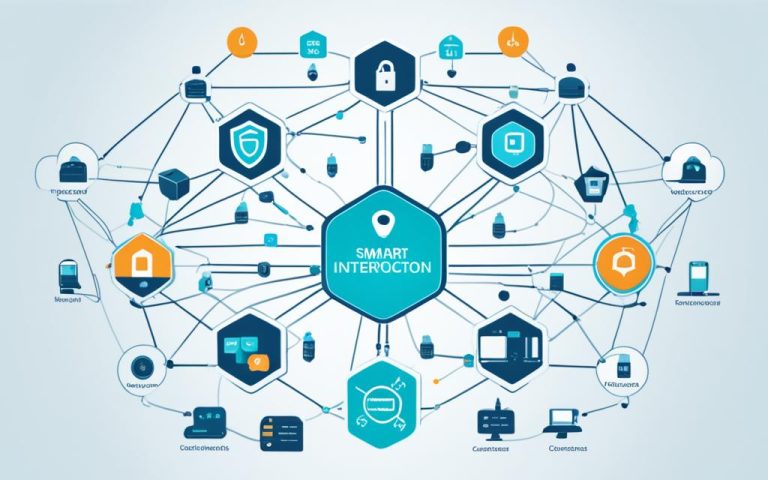Welcome to our article on implementing IPv6 over Personal Area Networks (PANs) and the benefits it brings for future-proof connectivity. In today’s interconnected world, where personal networks are essential for seamless communication and device integration, it is crucial to embrace IPv6 to ensure robust and scalable connectivity.
IPv6, the latest version of the Internet Protocol, offers significant advantages such as increased address space, improved security, and better support for mobile devices. By transitioning to IPv6, organizations can future-proof their networks, eliminating the limitations of IPv4 and positioning themselves for the connected world of tomorrow.
In this article, we will explore the key aspects of IPv6 over PANs, including its benefits, functionality, increased address space, enhanced security features, seamless integration with existing networks, support for mobile devices, and the importance of future-proofing your network.
So, let’s dive into the world of IPv6 and discover how it can revolutionize your personal area networks, ensuring future-proof connectivity for your devices and enabling seamless communication in today’s digitally-driven world.
Understanding IPv6: Benefits and Functionality
IPv6 is the next generation of Internet Protocol (IP) designed to replace IPv4. It brings a range of benefits and functionality that address the limitations of its predecessor. With IPv6, the internet can accommodate the growing number of devices and provide improved security features for enhanced connectivity.
At its core, IPv6 offers a larger address space compared to IPv4. While IPv4 provides 32-bit addresses, IPv6 utilizes 128 bits, providing a virtually unlimited pool of unique addresses. This benefit is particularly crucial as the internet of things (IoT) becomes more prevalent, with an increasing number of devices needing to be connected. IPv6 eliminates the need for address translation and allows each device to have a unique public address, ensuring efficient communication.
Additionally, IPv6 incorporates enhanced security features compared to its predecessor. It supports built-in encryption through Internet Protocol Security (IPsec), ensuring data confidentiality and integrity during transmission. This built-in security is especially significant in today’s threat landscape, safeguarding personal networks and sensitive data from potential attacks and unauthorized access.
Moreover, IPv6 provides better support for mobile devices, which are integral to personal networks. With IPv6, mobile devices can have their unique public IPv6 addresses, enabling seamless communication and connectivity. This allows for improved network efficiency and enhanced user experiences, catering to the needs of a highly mobile world.
Furthermore, IPv6 enables more efficient traffic routing. By using hierarchical addressing, IPv6 routing tables can be simplified, resulting in faster routing decisions and reduced network congestion. This streamlined routing capability ensures optimal performance and reliability, even in networks with a massive number of connected devices.
IPv6 brings tangible benefits such as a larger address space, improved security features, better support for mobile devices, and more efficient traffic routing. By embracing IPv6, organizations can future-proof their networks and unlock the full potential of personal area networks.
Overall, the advantages of adopting IPv6 are clear. It provides increased address space, improved security, better support for mobile devices, and more efficient traffic routing. By understanding the benefits and functionality of IPv6, organizations can stay ahead in this ever-evolving digital landscape, ensuring robust and scalable connectivity for their personal network devices.
Increased Address Space: Meeting the Growing Demand for Connectivity
As the demand for connectivity continues to grow at an unprecedented rate, the limitations of IPv4 address space are becoming more apparent. Fortunately, IPv6 offers a solution to this challenge with its significantly larger address space.
IPv6 utilizes a 128-bit address space, providing virtually unlimited unique addresses. This scalability ensures that there are enough addresses to accommodate the expanding number of devices and internet users. With IPv6, the potential for growth is boundless, offering a future-proof solution for organizations.
One of the key advantages of the increased address space in IPv6 is the elimination of the need for Network Address Translation (NAT). In IPv4, NAT was employed to conserve address space by allowing multiple devices to share a single public IP address. However, NAT introduces complexity and may cause issues with certain applications or protocols. With IPv6, each device can have its own unique public IP address, simplifying network configuration and enhancing connectivity.
The expanded address space of IPv6 also allows for automatic address configuration. With IPv6’s stateless address autoconfiguration (SLAAC), devices can generate their own unique addresses, eliminating the need for manual intervention in assigning IP addresses. This automation streamlines the process and saves valuable time for network administrators.
IPv6’s increased address space is a crucial component in meeting the growing demand for connectivity. It enables organizations to connect more devices to the internet without worrying about address exhaustion or the limitations of NAT. With IPv6, businesses can scale their networks to accommodate future growth and ensure seamless connectivity for all their devices.
As the digital landscape continues to evolve, it is clear that the demand for connectivity will only continue to rise. Embracing IPv6 and its expanded address space is essential for organizations looking to meet this growing demand and future-proof their networks.
Enhanced Security: Protecting Your Network and Data
In the world of network security, protecting your network and data has never been more crucial. With the rapid advancement of technology, the need for robust security measures is paramount. This is where IPv6 comes into play, offering enhanced security features that safeguard your network and ensure data protection.
One of the notable security features of IPv6 is built-in encryption with IPsec. This powerful encryption technology ensures the confidentiality and integrity of your data during transmission, making it extremely difficult for malicious actors to intercept or tamper with sensitive information.
IPv6 also provides better protection against attacks and data breaches with features like secure neighbor discovery and multicast security. Secure neighbor discovery prevents unauthorized devices from joining a network, minimizing the risk of unauthorized access. Multicast security, on the other hand, protects against attacks targeting multicast traffic, ensuring the integrity of data transmitted to multiple recipients.
Furthermore, the larger address space offered by IPv6 contributes to overall network security. With its extensive 128-bit address space, IPv6 makes it significantly harder for hackers to guess or scan devices on the network. This added layer of complexity acts as a deterrent and enhances the security of your network infrastructure.

This image depicts the essence of IPv6 security in an intuitive manner. The visual emphasizes the protective shield surrounding the network, representing the enhanced security features provided by IPv6.
In summary, IPv6’s enhanced security features, including built-in encryption, secure neighbor discovery, multicast security, and larger address space, play a crucial role in protecting your network and ensuring data protection. By embracing IPv6, you can fortify your network’s defenses and mitigate the risks associated with network security threats.
| IPv6 Security Features | Benefits |
|---|---|
| Built-in encryption with IPsec | – Ensures data confidentiality and integrity during transmission – Protects sensitive information from unauthorized access or tampering |
| Secure neighbor discovery | – Prevents unauthorized devices from joining the network – Minimizes the risk of unauthorized access |
| Multicast security | – Protects against attacks targeting multicast traffic – Ensures the integrity of data transmitted to multiple recipients |
| Larger address space | – Makes it harder for hackers to guess or scan devices on the network – Enhances overall network security |
Seamless Integration: Enhancing Connectivity with Existing Networks
When transitioning from IPv4 to IPv6, one of the key considerations for organizations is ensuring network compatibility and seamless integration. While there may be compatibility issues with older devices and software, proper planning and testing can address these challenges. IPv6 supports dual-stack deployment, allowing devices to operate on both IPv4 and IPv6 simultaneously, ensuring compatibility and uninterrupted connectivity.
Organizations can take several steps to facilitate the smooth integration of IPv6 into their existing networks. First, they should conduct a thorough inventory of their network infrastructure, identifying devices that support IPv6 and those that may require upgrades or replacements. This evaluation will provide a clear understanding of the necessary steps for successful integration.
Next, organizations should implement a phased approach to IPv6 deployment. This allows them to gradually introduce IPv6 into their network while maintaining the functionality of existing IPv4 devices. By gradually migrating devices and services to IPv6, organizations can minimize disruption and ensure a smooth transition for both users and applications.
During the integration process, it is essential to prioritize network compatibility. Organizations should ensure that IPv6-enabled devices and software are compatible with existing network equipment and infrastructure. This can include routers, switches, firewalls, and other crucial components. Compatibility testing is crucial to identify and address any potential issues or conflicts before full deployment.
Furthermore, organizations should work closely with vendors and service providers to ensure that their network devices and applications are IPv6 compliant. This collaboration can help address any compatibility issues and ensure a seamless integration experience.
IPv6 integration also presents an opportunity for organizations to optimize their network architecture and implement best practices. It allows for the elimination of workarounds such as Network Address Translation (NAT), simplifying network administration and enhancing overall network performance.
“Successful IPv6 integration requires careful planning, compatibility testing, and collaboration with vendors. By ensuring a seamless transition, organizations can embrace the benefits of IPv6 while maintaining uninterrupted connectivity.”
Overall, seamless integration of IPv6 into existing networks is crucial for organizations to fully harness the benefits of this advanced protocol. With proper planning, compatibility testing, and collaboration, businesses can confidently adopt IPv6, future-proof their networks, and enhance connectivity.
Support for Mobile Devices: Enabling Mobility in Personal Networks
As mobile devices continue to play a crucial role in personal networks, the support for these devices becomes increasingly important. With the adoption of IPv6, personal networks can provide better connectivity and seamless communication for mobile devices. One of the key advantages of IPv6 is the ability to assign unique public IPv6 addresses to mobile devices, ensuring efficient and secure connectivity.
IPv6-enabled mobile devices can seamlessly communicate with each other and the internet, enhancing the overall user experience. The advanced features of IPv6, such as improved routing and network efficiency, further optimize the performance of mobile devices in personal networks.
“With the support for mobile devices in IPv6, personal networks can provide enhanced mobility, allowing users to stay connected and productive while on the move.”
Better Network Efficiency for Mobile Devices
IPv6’s advanced features contribute to improved network efficiency for mobile devices in personal networks. With its larger address space, IPv6 eliminates the need for network address translation (NAT), simplifying the routing process and reducing latency. This allows mobile devices to communicate directly with other devices and servers, resulting in faster and more efficient data transmission.
Enhanced User Experience
The superior support for mobile devices in IPv6 significantly enhances the overall user experience. With unique public IPv6 addresses, mobile devices can establish direct connections and enjoy seamless communication within personal networks. This ensures faster response times, improved reliability, and better quality of service for mobile applications and services.
Future-Proofing Personal Networks
By embracing IPv6 and its support for mobile devices, personal networks are future-proofed and well-equipped to handle the increasing demands of connectivity. As mobile technology continues to advance, IPv6 remains compatible with emerging devices and applications, ensuring continued seamless integration and connectivity.
Future-Proofing Your Network: Embracing the Advantages of IPv6
By adopting IPv6, organizations can future-proof their networks and ensure they are ready for the connected world of the future. IPv6 offers scalability, better security, and support for emerging technologies. It eliminates the limitations of IPv4 and positions businesses to take advantage of new opportunities as they arise. Embracing IPv6 now allows organizations to stay ahead of the curve and avoid the potential challenges of IPv4 exhaustion.
Scalability: Meeting the Growing Demands
One of the most significant advantages of IPv6 is its scalability. With the growing number of devices and internet users, the need for a larger address space is crucial. Unlike IPv4, which has a limited number of available addresses, IPv6 offers a virtually unlimited pool of unique addresses. This scalability ensures that organizations can connect and manage an increasing number of devices without worrying about address exhaustion.
Better Security: Safeguarding Your Network and Data
IPv6 provides enhanced security features to protect networks and data. One of these features is built-in encryption with IPsec (Internet Protocol Security). By encrypting data during transmission, IPv6 ensures confidentiality and integrity, making it significantly harder for malicious actors to intercept and manipulate information. Additionally, IPv6 incorporates more robust mechanisms to defend against network attacks and breaches, such as secure neighbor discovery and multicast security.
Support for Emerging Technologies: Staying Ahead of the Curve
As technology continues to evolve, IPv6 is designed to support emerging advancements and innovations. The adoption of IPv6 enables organizations to harness the full potential of Internet of Things (IoT) devices, cloud computing, and other cutting-edge technologies. With its larger address space and advanced capabilities, IPv6 lays the foundation for future network expansion, allowing businesses to seize new opportunities and stay competitive in the evolving digital landscape.
| IPv6 Advantages | IPv4 Limitations |
|---|---|
| Scalable address space | Address exhaustion |
| Built-in security features | Limited security capabilities |
| Supports emerging technologies | May not fully support new technologies |
Conclusion
IPv6 implementation is the key to achieving future-proof connectivity for personal area networks. By adopting IPv6, organizations can unlock a range of advantages that support seamless and secure communication across devices and networks.
One major benefit of IPv6 is the increased address space it offers, ensuring scalability and accommodating the growing demand for connectivity. This eliminates the need for Network Address Translation (NAT) and simplifies address management through automatic configuration.
In addition to address space, IPv6 enhances network security through built-in encryption and features such as secure neighbor discovery and multicast security. The larger address space also makes it more challenging for hackers to infiltrate personal networks, providing a higher level of protection for data and devices.
Although implementing IPv6 may involve some compatibility issues and require training, the advantages far outweigh the drawbacks. Organizations that embrace IPv6 can future-proof their networks, simplify network administration, and ensure robust and scalable connectivity for their personal network devices. By staying ahead of the curve and adopting IPv6, organizations can position themselves for success in the connected world of the future.
FAQ
What is IPv6?
IPv6 is the latest version of the Internet Protocol (IP) that offers advantages such as increased address space, improved security, and better support for mobile devices.
Why should organizations adopt IPv6?
Organizations should adopt IPv6 to future-proof their networks, ensure scalability, improve security, and take advantage of emerging technologies.
What are the advantages of IPv6?
The advantages of IPv6 include increased address space, improved security, better support for mobile devices, simplified network administration, and future-proofing benefits.
How does IPv6 address the growing demand for connectivity?
IPv6 provides a significantly larger address space than IPv4, ensuring scalability and future growth to meet the growing number of devices and internet users.
How does IPv6 enhance network security?
IPv6 offers improved security features, including built-in encryption with IPsec, secure neighbor discovery, multicast security, and a larger address space that makes it harder for hackers to guess or scan devices on the network.
Can IPv6 seamlessly integrate with existing networks?
Yes, IPv6 can seamlessly integrate with existing networks, allowing for a smooth transition from IPv4. Organizations can address compatibility issues through proper planning and testing.
How does IPv6 support mobile devices in personal networks?
IPv6 provides better support for mobile devices by enabling them to have their unique public IPv6 addresses, ensuring seamless communication and connectivity. IPv6’s advanced features also improve network efficiency for mobile devices and enhance the user experience.
How does embracing IPv6 future-proof your network?
Embracing IPv6 future-proofs your network by eliminating the limitations of IPv4, ensuring scalability, better security, support for emerging technologies, and positioning your organization to take advantage of new opportunities.



















